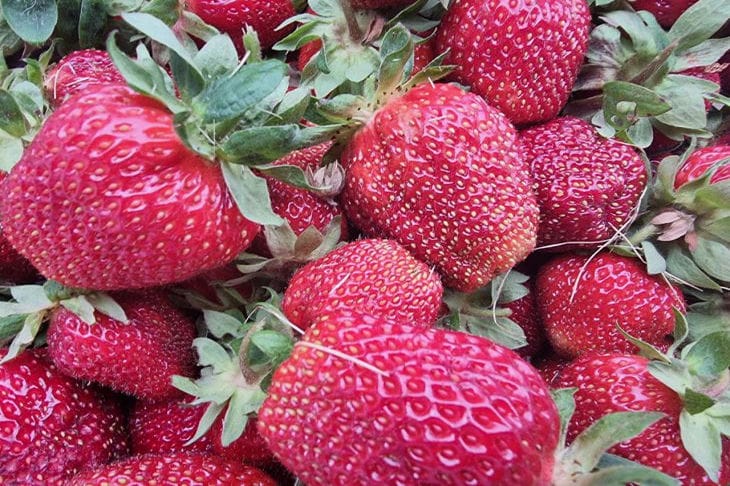Strawberries are one of the most popular and beloved berry plants, grown both for personal consumption and for commercial purposes.
A good harvest of sweet and juicy strawberries requires not only proper care, but also systematic nutrition.
In this article, I will share with you some tips on feeding strawberries that will help you increase the yield and quality of the berries, says Anastasia Kovrizhnykh .
Organic fertilizer
Organic fertilizer is an excellent choice for feeding strawberries.
Use natural ingredients such as humus, compost or organic fertilizers based on seaweed substance.

They are rich in essential nutrients and microelements that will help strawberries grow healthy and produce larger berries.
Nitrogen fertilizer
Nitrogen is an essential element for plant growth, including strawberries. Feed your plants with nitrogen fertilizer early in the growing season and after your first harvest.
Nitrogen will help stimulate leaf growth and rooting, which in turn will affect the number and size of berries. Use nitrogen carefully, according to the instructions. Urea - 1 tablespoon per bucket of water 10 liters.
Phosphorus fertilizer
Phosphorus is necessary for the development of the root system, flowering and fruit formation in strawberries. Feed the plants with phosphorus fertilizer before planting and during the formation of buds.
Choose fertilizers with a high phosphorus content, such as phosphate flour or superphosphate. Regular application of phosphorus fertilizers will help improve the yield and quality of berries.
Potassium fertilizer
Potassium helps strengthen plants, improves their resistance to disease and stress, and increases the sugar content of berries.
Feed the strawberries with potassium fertilizer during the period of active growth and before the berries begin to ripen. The optimal ratio between nitrogen and potassium in the fertilizer will help achieve a good balance between plant growth and fruit development.
Microelements
It is also important to provide strawberries with the necessary microelements. Vitamins and minerals such as iron, magnesium, zinc and copper play an important role in the metabolic processes of plants.
Use complex fertilizers that contain all the necessary microelements.
Pay attention to the condition of the plants and, if necessary, conduct a soil analysis to determine the deficiency of specific micronutrients.
Top dressing during the season
Regular fertilizing of strawberries throughout the growing and fruiting season is a key factor in achieving high yields.
Divide the fertilizing into several stages, starting with preparing the soil before planting and ending with the last fertilizing after the main harvest.
Follow the directions on the fertilizer package and do not overdo the dosage to avoid nutrient overload.
This is important! Do not forget that proper watering is also an important component of successful strawberry growing. After all, it is with water that fertilizers penetrate the roots.
Foliar feeding
In addition to root feeding, do not forget about foliar feeding. Strawberry leaves are capable of absorbing nutrients, so spraying a fertilizer solution on their surface can be an effective way to provide the plants with the necessary nutrients.
Use special foliar fertilizers that contain microelements and feed the leaves regularly, especially during periods of intensive growth and flowering.
Follow fertilizer manufacturers' recommendations.
When choosing and using fertilizers, always follow the manufacturer's recommendations. Each fertilizer has its own application and dosage features, so it is important to carefully read the instructions.
Incorrect application of fertilizers can result in plants being overloaded with nutrients or lacking important elements, which can negatively affect their growth and yield.
Systematicity and observation
It is important to approach strawberry fertilization systematically and observe the plants' reactions. They may consume nutrients differently depending on growing conditions, so it is important to regularly check the condition of the plants, as well as analyze the soil and leaves. If necessary, adjust the fertilization and choose fertilizers that meet the needs of the plants.
Folk recipes for feeding strawberries
In addition to using commercial fertilizers, foliar feeding of strawberries can be done using folk recipes that use available and natural ingredients. Here are some examples of such feedings:
Tea feeding:
1. Pour 1 liter of boiling water over 1 teaspoon of tea (black or green).
2. Let it brew for a few hours, then strain.
3. Dilute with water in a ratio of 1:5.
4. Use for watering strawberries once every 2-3 weeks. The tea contains a small amount of nitrogen, potassium and microelements that will be useful for the growth and development of plants.
Egg feeding:
1. Take 2-3 eggshells and grind them into powder.
2. Dilute the shell powder in 1 liter of water and mix thoroughly.
3. Let it sit for 24 hours, then strain.
4. Water the strawberries with the solution, generously irrigating the root zone of the plants. Egg dressing contains calcium and other microelements that will help strengthen the strawberries and increase their yield.
Nettle top dressing:
1. Collect fresh nettles and pour boiling water over them.
2. Let it sit for 24 hours, then strain.
3. Dilute the resulting fertilizer with water in a ratio of 1:10.
4. Water the strawberries with this solution, paying special attention to the root zone. Nettle is rich in nitrogen and microelements that promote plant growth and development.
Ash. Top dressing:
1. Mix 1 tablespoon of wood ash with 1 liter of water.
2. Stir until the ash is completely dissolved.
3. Water the plants with this solution, thoroughly irrigating the root zone.
4. Ash contains potassium and other microelements that promote the development of the root system and improve strawberry yields.
Compost top dressing:
1. Prepare compost from organic waste such as vegetable and fruit scraps, grass, leaves and other plant materials.
2. Spread compost around the root zone of the strawberries, creating a layer about 5-7 cm thick.
3. Carefully bury the compost into the soil and water the plants.
4. Compost enriches the soil with organic matter and microorganisms, improving its fertility and promoting healthy strawberry growth.
It is important to remember that folk recipes for foliar feeding can be useful additions to the main plant nutrition system.
Before using any fertilizers, including folk ones, it is recommended to conduct a small experiment on a limited area.
This way you will assess the reaction of the plants and be able to avoid possible negative consequences.
Combining different types of fertilizers can also be effective in helping to provide strawberries with all the nutrients they need for optimal growth and yield.
By following these strawberry fertilizing tips, you can increase the yield and quality of your berries.
However, remember that success in growing strawberries depends not only on feeding, but also on general plant care, including proper watering, mulching, and pest and disease control.
Follow all the recommendations, and you will be able to enjoy delicious and abundant strawberries from your own harvest.
Earlier, the expert explained which plants will prevent cucumbers from yielding a harvest.









